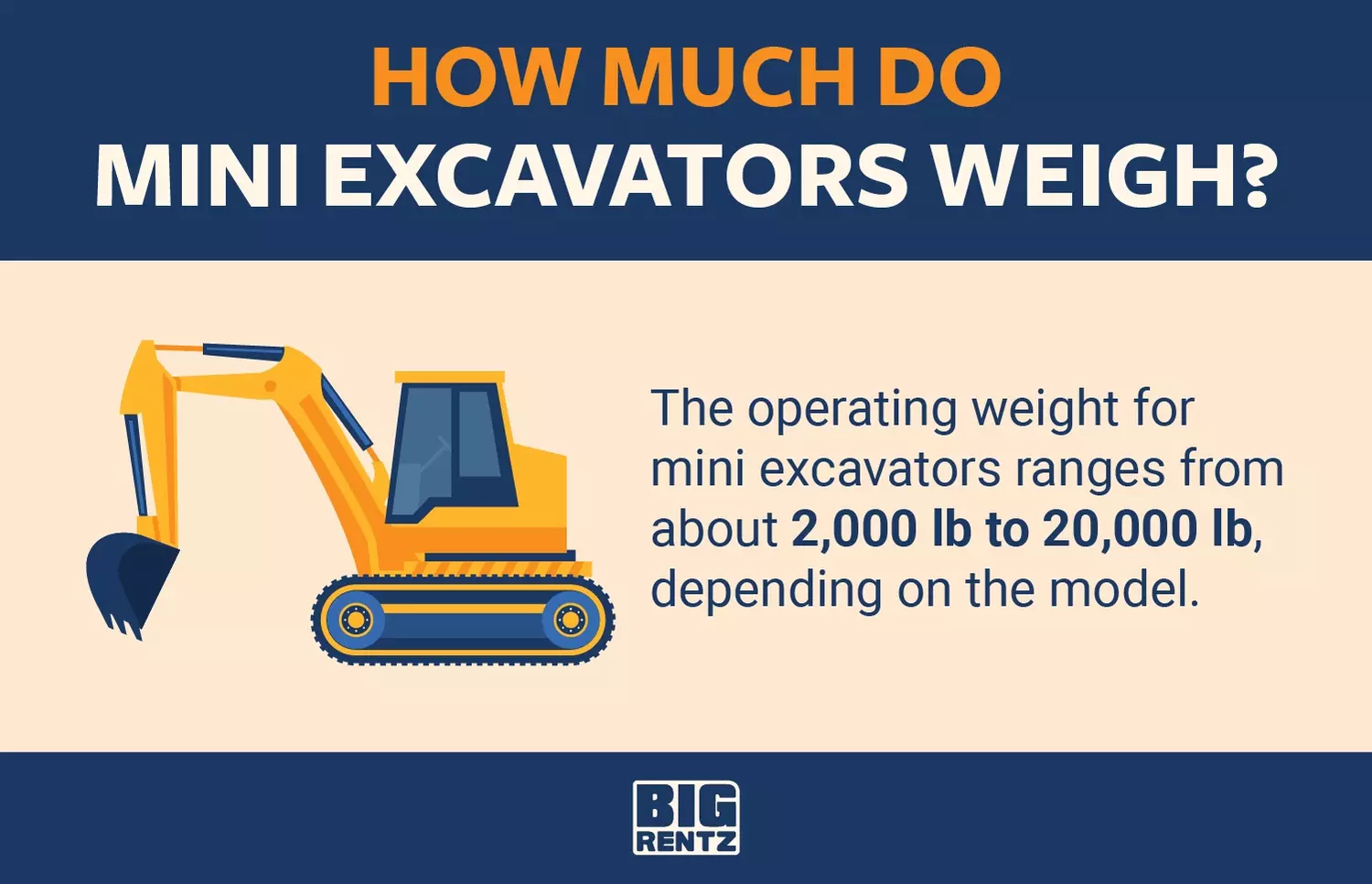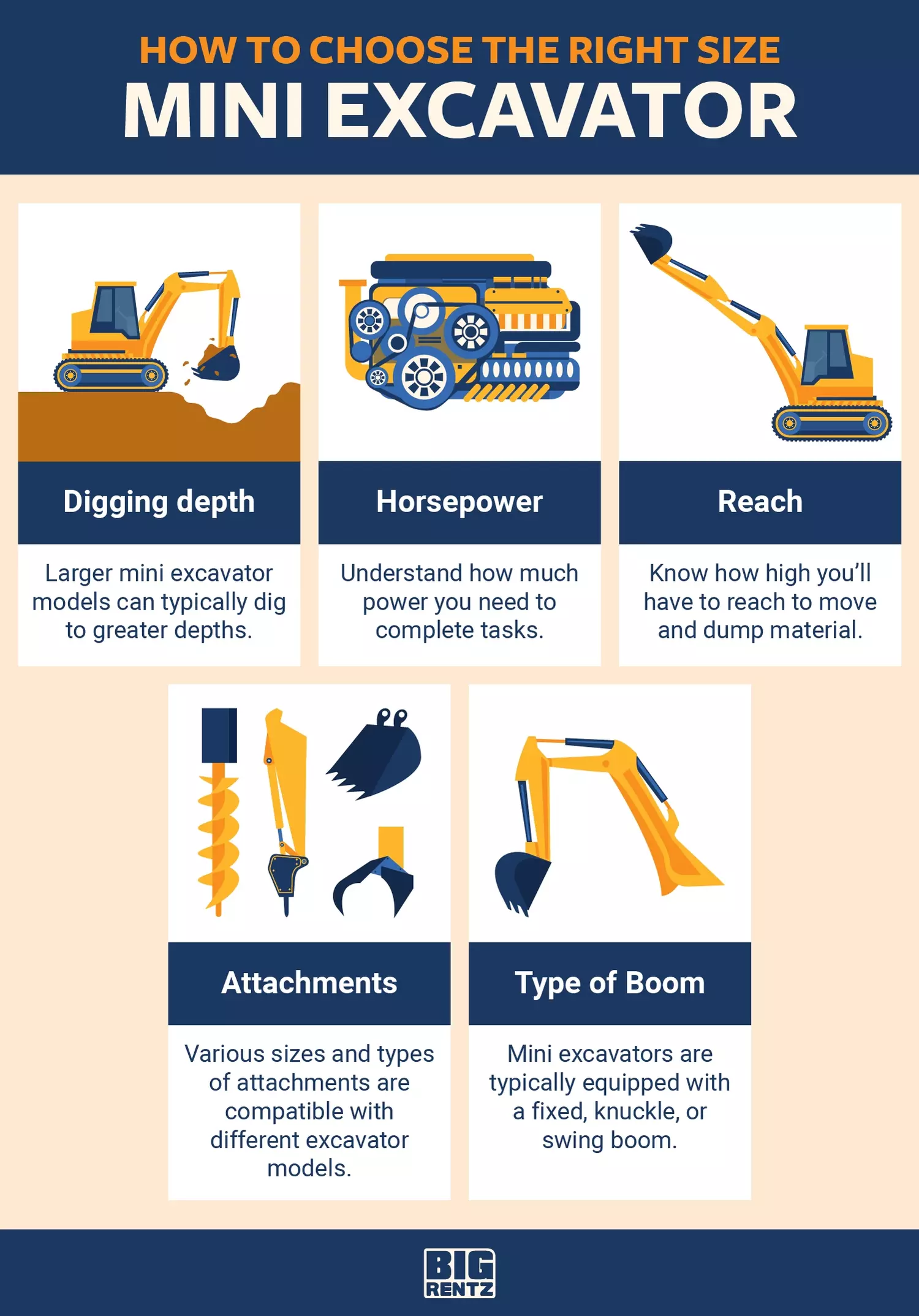Keywords: mini excavator with auger, cat 309 excavator for sale
mini excavator with auger
cat 309 excavator for sale
If you need a small excavator that can fit into tight spaces where standard-sized vehicles can’t, consider using a mini excavator, also known as a compact excavator. Although they are the smallest excavator weight class and less powerful than standard excavators, you can use them to dig trenches and ditches. In fact, you may find yourself choosing a mini excavator for projects like outdoor landscaping, home renovations, sewer repairs, and water line installations.
You measure a mini excavator by its operating weight, which is the machine’s total weight while in use, including any attachments. Knowing the operating weight of your excavator allows you to safely operate the machine within its limits and ensure that it’s the appropriate machine to use on your jobsite.
In this post, we go over mini excavator operating weights, important specs, and tips on how to choose the right size excavator for your job.
Explore All Mini Excavators
Table of contents
- How Much Do Mini Excavators Weigh?
- Common Mini Excavator Operating Weights
- How to Determine A Mini Excavator’s Weight
- How to Choose the Right Size Mini Excavator
- Mini Excavators vs. Standard Excavators
- How Much Does a Mini Excavator Rental Cost?
- Need to Rent a Mini Excavator?
How Much Do Mini Excavators Weigh?
Generally, you’ll find that mini excavator operating weights range from 2,000 to 20,000 pounds, depending on the model. This may sound pretty heavy for a “mini” machine, but they’re small compared to standard excavators, which range from 22,000 to 99,000 pounds.
You can count on heavier and larger machines to have more horsepower and deeper maximum dig depths.

How Attachments Impact the Operating Weight
You can use a wide range of attachments with a mini excavator, but each attachment’s individual weight contributes to the overall operating weight of your mini excavator.
If you’re wondering how attachments might affect the operating weight of your machine, this list of the most common excavator attachments provides approximately how much weight they add:
- Bucket—12”/63 lb: If your job requires sloping, leveling, and backfilling, you can scoop up soft materials, like soil with the bucket attachment.
- Auger—285 lb: You can break up hard ground and remove debris as well as dig holes with an auger attachment.
- Hydraulic breaker—659 lb: You can use a hydraulic breaker to break up hard material. Although an auger does the same thing, you get even more power with a hydraulic breaker. Thanks to its auxiliary hydraulic system, you can break up concrete structures and rocks, which is why it’s often used in demolition.
- Clamp—218 lb: If you need to remove debris, like tree stumps and broken concrete from a worksite, using a clamp attachment holds cumbersome objects better than a bucket.
- Grapple—200 lb: You can use grapples to pick up, transport, and sort debris and material that other attachments can’t manage. You’ll find them useful for many material-handling applications to make easy work of grabbing and maneuvering hard-to-reach, unwieldy material.
Common Mini Excavator Operating Weights
The weight of a mini excavator will vary based on the model. You can find the operating weights of popular excavator models below.
| Model | Operating weight (lb) | Horsepower (hp) | Digging depth (ft) |
| Bobcat E10 | 2,593 | 10 | 6 |
| John Deere 26G | 6,110 | 20 | 8.5 |
| Kubota KX057-5 | 12,346 | 48 | 12.75 |
| CAT 308 CR | 20,077 | 70 | 15.2 |
How to Determine A Mini Excavator’s Weight
You should consult the manufacturer’s instruction manual to find out the operating weight of your mini excavator. Usually, the weight is stated in the manual or on the data plate.
Like any piece of construction equipment, make sure you read through the operator manual before using it. That way, you know the machine’s limitations and know how to operate it safely.
If you’re looking for a mini excavator to rent, BigRentz lists mini excavators by their operating weights.
How to Choose the Right Size Mini Excavator
Before selecting a mini excavator, you should consider factors that impact your project, such as dig depth, horsepower, and reach to name a few. Use the factors in the next sections to guide your selection when checking out a mini excavator to rent.
- Digging depth: You can dig about 6 feet with the smallest mini excavators and up to 16 feet with larger models, so consider your project’s requirements to ensure you select an excavator that can dig to the depth you need.
- Horsepower: You can find a wide range of horsepower with compact excavators, which start around 10 horsepower and go all the way up to about 75 horsepower. Because attachments factor into how much power you need, make sure to understand each attachment’s requirements so that you select an excavator with the right amount of horsepower to meet your needs.
- Reach: Consider how far away from the machine you’ll need to dig and how high you’ll need to lift materials. For example, you may need to deposit materials into a dump truck for easy transportation and disposal.
- Attachments: Most mini excavators support various attachments, but you need to check the horsepower requirements and operating weight needs of each attachment.
- Type of boom: You can find one of three booms on mini excavators: fixed, knuckle, or swing. You can use swing booms, the most common, to move both up and down and side to side. Because knuckle and fixed booms are mounted directly to the frame, you get a more limited range of motion.

Mini Excavators vs. Standard Excavators
A standard excavator can give you a lot of power for digging. However, if maneuvering in small, tight spaces, not high power, is your top priority, you should consider a mini excavator. These points of comparison can help you get a sense for which piece of equipment is best for your needs:
- Size: Because mini excavators are smaller and lighter than standard excavators, they are ideal for working in tight spaces, on small jobs, and in areas that are susceptible to surface damage. You’ll probably need a standard excavator, however, if you have a big job with a large scope and high power demands.
- Maneuverability: Offering superb maneuverability, some mini excavators even come with retractable undercarriages, making it even easier for you to navigate in tight areas.
- Versatility: Although both types of excavators offer versatility, the standard excavator has more horsepower. Because the standard excavator has more horsepower, it can support more attachments and may work more efficiently than the mini version.
- Bucket capacity: Because of the larger size of a standard excavator, you get a bigger bucket as well as a deeper maximum dig depth.
- Reach: While standard size excavators can reach higher and lift heavier loads. Mini excavators can reach into narrower areas.
- Cost: Due to their smaller size and limited capacities, mini excavators tend to cost less to buy or rent than standard excavators.
How Much Does a Mini Excavator Rental Cost?
If you want to rent a mini excavator, your location, the size of the excavator, and the rental duration will impact the rental cost. You can rent one from $225 to $575, with weekly rates ranging from $700 to $1,550, and monthly rates ranging from $1,800 to $3,675.
Download our FREE mini excavator rental guide e-book today!
Need to Rent a Mini Excavator?
Ready to rent a mini excavator? You can find a wide variety of mini excavators from BigRentz. Ranging from 2,000 to 20,000 pounds, there’s sure to be an option that fits your project needs.
Explore All Mini Excavators